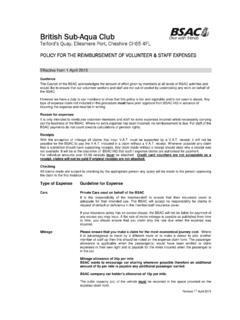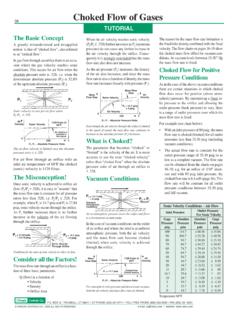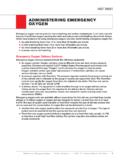Transcription of How Rebreathers Kill People - Deep Life Ltd (IBC ...
1 How Rebreathers kill People Updated to 2016. Slide 1 Deep Life Ltd For those times when equipment must work Sources of Safety Data Failure Mode Effect and Criticality Analysis (FMECA). Incident Reports: Interview with survivors of incidents reported from dive clubs Coroner s Reports Fully Documented Fatalities Web sites maintaining partial rebreather fatality lists Forums advising of accidents, with follow up interviews where possible CCR Manufacturers' reports HSE Reports IMCA Reports BSAC Dive Accident Reports DAN Accident Reports Slide 2 Deep Life Ltd For those times when equipment must work Diving Hazards and Rebreathers Diving is in itself a hazardous activity, with risk of fatality between 1 in 10,000. and 1 in 80,000 hours: around 1 in 9,000 diver years. The highest socially acceptable risk is considered to be that of a woman giving birth in a developed country: a 1 in 9000 risk of a fatal outcome. Some Rebreathers are more than 100 times more dangerous.
2 The fatal accident rate on CCRs is as high as 1 in 13 units manufactured for particular rebreather models, and is around 1 in 100 on average (in 2016). That is an extraordinarily high risk. Risks posed by diving in general are catalogued in The Physiology and Medicine of Diving , P. Bennett & D. Elliott (4th Edition). CCR diving entails a much higher level of risk than Open Circuit diving, from DAN, HSE and BSAC reports. This implies there are additional hazards not listed by Bennett & Elliott. The increased risk of CCR diving is not explained by lack of training: CCR divers tend to be much more experienced and trained than the Open Circuit divers. In FMECA reviews of third party CCR designs, a strong correlation between design defects and the accident rate of any particular rebreather was observed: that is, between a low MTBCF and a high fatality rate. This report describes some rebreather incidents, the failure modes those reveal, and how the associated risks can be reduced.
3 Slide 3 Deep Life Ltd For those times when equipment must work FMECA Reports Requirement of EN14143 that manufacturers perform a FMECA (Failure Mode Effect and Criticality Analysis). No requirement within EN14143 to publish the FMECA or any test results. Most manufacturers are keeping their FMECA confidential, if it even exists at all. EN14143:2003 requires Functional Safety compliance to EN 61508, which in turn requires 1 billion hour fault tolerance, but is not implemented by manufacturers (CE. Marks are being put on equipment falsely). In 2013 manufacturers succeeded in removing Functional Safety requirements from the CE process: compliance with IEC EN 61508 was removed from EN. 61508, against the advice of many safety specialists. Non-CE Rebreathers being sold, with NO testing even of ability to control PPO2. Users and Government Safety Organisations are turning a blind eye to the death rate. Result is no pre-2011 rebreather can tolerate one worst-case failure.
4 Result is users have not the faintest idea of the safety of what they are diving. Result is no-one can challenge wrong conclusions in a FMECA. Result is there is no FMECA data on which to build better systems. Recommendation: All manufacturers selling any piece of life critical equipment to the public should publish the full FMECA Report on their web site along with the EN. 61508 calculation and safety case. Slide 4 Deep Life Ltd For those times when equipment must work Some of the incidents 1) Computer decided to do an O2 sensor cal underwater, all on its own 2) Rebreather controller hanging 3) Displaying completely wrong PPO2 values on all cells due to water block 4) Sudden massive flood, including CO2 hit and caustic cocktail 5) Two O2 sensors fail (from same batch). 6) ISC APECS bug injects only 1/20th the amount of O2 intended 7) Mistakenly injecting O2 on descent instead of diluent 8) Loss of diluent on descent 9) O2 injector sticks on 10) Connector mismated: flood 11) Manifold O ring fails 12) CO2 retention due to increase in Work of Breathing caused by fitting faulty component 13) CO2 hits due to scrubber failure 14) Unit not switched on 15) PPO2 falls below that required to sustain life due to water block 16) O2 injection rate insufficient for ascent 17) PPO2 set point allowed to be lower than that required for safe ascent 18) Errors in O2 sensor calibration 19) Bugs in decompression software 20) CNS toxicity 21) Use of uncalibrated O2.
5 22) Solenoid power drain causes PPO2 to read incorrectly, affecting PPO2 control Slide 5 Deep Life Ltd For those times when equipment must work Incident 1: Jump to O2 Cal Location: Scapa Flow, May Dive Profile: Diving to 100ft, displays showed PPO2 at set point of Incident Report: I heard O2 injector come on and stayed on all of its own accord. Looked at handset. The Inspiration controller had jumped to performing a calibration and was injecting pure O2. No alarms. Bailed out.. Cause: System checked by qualified electronics engineer.. Unused memory locations were random codes when they should have been a jump to a recovery point.. There was no Watchdog Timer installed an essential safety feature.. The brown-out circuit was completely ineffective. Power supply circuit prone to brown-out. Manufacturer advised, corrected shortcomings on new product, but did not recall anything. These faults were not disclosed to coroners investigating deaths, in circumstances where the coroner may have concluded the CCR controller was the cause if disclosure was made.
6 The electronics design and software design was absolutely incompetent. It later transpired that APV had used Nick Hester to perform this work when Mr Hester had no engineering training whatsoever he was a salesman. Project Manager also had nil engineering training. Recommendation: Functional Safety requirements need to be reinstated and enforced: application of EN 14143:2003 and its requirement to meet EN 61508, would have prevented deaths where the cause was the circuit errors listed above. Employing competent staff would have avoided the above. The sale of these controller is damnable. Slide 6 Deep Life Ltd For those times when equipment must work Incident 2: Hanging Controller Location: Scapa Flow, June Dive Profile: Diving to 110ft, displays showed PPO2 at set point of Incident Report: It occurred to me that the O2 injector was not firing (it was silent for too long). Did a flush. Displays stayed the same. Did not respond to buttons.
7 Concluded computer had hung. No alarms sounded. Tried switching off and back on. Computer insisted on calibrating sensors. On cal, computer injected pure O2 even though depth was 110ft. Bailed out. If I had not been listening for the O2 injector, I would be dead.. Cause: System checked by qualified electronics engineer. Unused memory locations were random codes when they should have been a jump to a recovery point. There was no Watchdog Timer installed. The Brown-Out Circuit was tested and design found to be completely ineffective. Power supply circuits were prone to brown out. Manufacturer advised, corrected shortcomings on new product, but did not recall any product Many deaths on this product are due to the above fault. Recommendation same as Incident 1. Note the same causes, result in a different fault manifestation: what happens depends on what random address the program jumps to. Slide 7 Deep Life Ltd For those times when equipment must work Incident 3: PPO2 Reading False Location: Turkey Incident Reports: 3 cell analogue PPO2 monitor fitted to inhale counterlung, using a third party cell holder, and this then routed to eCCR controller as eCCR controller was untrustworthy.
8 On quayside, eCCR was maintaining a PPO2 of atm well. Prebreathe of 5 minutes. Dived in, noticed PPO2 was not changing. At 10m injected O2, and PPO2. display still did not change. Bailed out and aborted dive. Back on quayside, unplugged O2. cell holder and analogue PPO2 display was still showing for all cells for several minutes in air. Slowly cell outputs changed to show Water could be seen drying from cell membranes. Cause: Water block on cell membranes, meant the rebreather controller was effectively blind. This can produce both hypoxia and hyperoxia, depending on what the cells are showing when the water block occurs. Recommendations: Manufacturers MUST test for PPO2 accuracy in worst case conditions of maximum length dives, in both coldest and hotest water, with rapid ascent and descent. Never locate O2 cells in condensing locations, such as the counterlungs or immediately post scrubber. Cell holder must form a water well.
9 Cells should have a rapid gas flow across them in a breathing hose. Slide 8 Deep Life Ltd For those times when equipment must work Incident 4: Sudden Flood Location: Lower Clyde, June Dive Profile: Deep Support Diver for an extremely deep dive Incident Report: Sudden massive flood and CO2 hit. Caustic cocktail inhaled, lots of it. Difficult getting back to surface and staying on surface due to loss of buoyancy because of flood. When CO2 hit, under influence of CO2 hit, caustic cocktail in mouth but hallucinated it was in nose. No warning headache. Became a critical situation. Averted by last second bail out. Due to CO2 did not think of dropping my weight belt.. Forums and bulletin boards contain a number of similar reports. Cause: Caused by inadequate keying of hose connector into scrubber: unit passes pressure tests with hose rotated and not in keyed position, if hose nut is tightened down. However, a bump on the hose causes it to fail with water pouring into the scrubber.
10 The hose keying is a serious design fault. Manufacturer advised, disregarded problem. Charged for service of rebreather, writing Not dishwasher proof on inside of scrubber lid after user completely stripped it down and tried a dishwasher to remove caked on caustic chemicals. Early warning of a flood (gurgle) not covered in course. Recommendation: FMECA should have highlighted the problem. This indicates that no adequate FMECA was carried out. The manufacturer has since changed their training procedure and manuals to highlight the effect of a flood. Slide 9 Deep Life Ltd For those times when equipment must work Incident 5: Two O2 Sensors Fail Location: Dunbar, August Dive Profile: To 160ft, Beside Bass Rock Incident Report: One O2 sensor failed during dive (lower than others). Running on 2 sensors. Then injector was injecting more often than I would expect given constant depth. Flush indicated PPO2 was different to what I.





